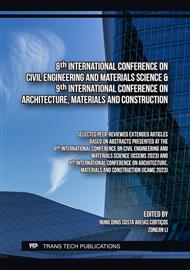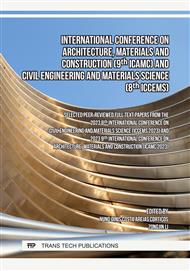[1]
Parmesan, C., M.D. Morecroft, Y. Trisurat, R. Adrian, G.Z. Anshari, A. Arneth, Q. Gao, P. Gonzalez, R. Harris, J. Price, N. Stevens, and G.H. Talukdarr. (2022). Terrestrial and Freshwater Ecosystems and their Services. In: Climate Change 2022: Impacts, Adaptation, and Vulnerability. Contribution of Working Group II to the Sixth Assessment Report of the Intergovernmental Panel on Climate Change. Cambridge University Press. In Press.
DOI: 10.1017/9781009325844.004
Google Scholar
[2]
IPCC. (2022). Climate Change 2022: Impacts, Adaptation, and Vulnerability. Contribution of Working Group II to the Sixth Assessment Report of the Intergovernmental Panel on Climate Change. Cambridge University Press. In Press.
DOI: 10.1017/9781009325844
Google Scholar
[3]
Talukdarr. (2022). Terrestrial and Freshwater Ecosystems and their Services. In: Climate Change 2022: Impacts, Adaptation, and Vulnerability. Contribution of Working Group II to the Sixth Assessment Report of the Intergovernmental Panel on Climate Change. Cambridge University Press. In Press.
DOI: 10.1017/9781009325844.004
Google Scholar
[4]
United Nations Framework Convention on Climate Change (UNFCCC). (2015) Paris agreement: decision 1/CP.17 - UNFCCC document FCCC/CP/2015/L.9/Rev.1.
DOI: 10.4324/9780203888469-65
Google Scholar
[5]
Del Borghi, A., Spiegelhalter, T., Moreschi, L., and Gallo, M. (2021). Carbon-Neutral-Campus Building: Design Versus Retrofitting of Two University Zero Energy Buildings in Europe and in the United States, Sustainability.
DOI: 10.3390/su13169023
Google Scholar
[6]
Ian Hamilton and Dr. Harry Kennard, 2020.12.16, 2020 GLOBAL STATUS REPORT FOR BUILDINGS AND CONSTRUCTION, GlobalABC
Google Scholar
[7]
IPCC. (2018). Global Warming of 1.5 ºC.
Google Scholar
[8]
EqualOcean Intelligence. (2021). 2021 Research Report on Carbon Neutral Implementation Pathways for Commercial Buildings in China.
Google Scholar
[9]
Faming Wang, Christian J Sanders, Isaac R Santos, Jianwu Tang, Mark Schuerch, Matthew L Kirwan, Robert E Kopp, Kai Zhu, Xiuzhen Li, Jiacan Yuan, Wenzhi Liu, Zhi'an Li. (2021). Global blue carbon accumulation in tidal wetlands increases with climate change, National Science Review, Volume 8, Issue 9, September 2021, nwaa296, https://doi.org/.
DOI: 10.1093/nsr/nwaa296
Google Scholar
[10]
Lin Borong, (2021). Exploring the Challenges and Pathways to Carbon Neutrality in the Construction Industry, Sustainable Development Economic Guide.
Google Scholar
[11]
Information from https://www.powerhouse-company.com/floating-office-rotterdam
Google Scholar
[12]
Information from https://research.gatech.edu/energy/cnes_building
Google Scholar
[13]
Sun Junwei, Wang Binghui, Zhang Hanqun, 2019, Study on Energy-saving Measures and Economic Benefit of Construction Engineering, Engineering Construction.2019,2(6).149-151
DOI: 10.33142/ec.v2i6.434
Google Scholar
[14]
Perkol-Finkel, S., Hadary, T., Rella, A., Shirazi, R., & Sella, I. (2018). Seascape architecture- incorporating ecological considerations in design of coastal and marine infrastructure. Ecological Engineering, 120, 645-654.
DOI: 10.1016/j.ecoleng.2017.06.051
Google Scholar



